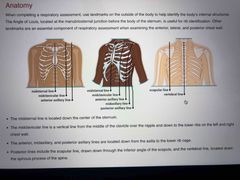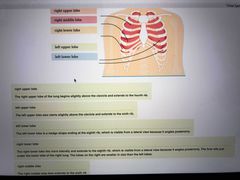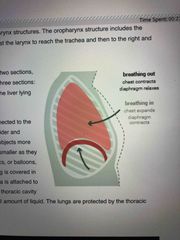![]()
![]()
![]()
Use LEFT and RIGHT arrow keys to navigate between flashcards;
Use UP and DOWN arrow keys to flip the card;
H to show hint;
A reads text to speech;
17 Cards in this Set
- Front
- Back
- 3rd side (hint)
|
Respiratory assessment |
-respiratory assessments are done every eight hours in the hospital setting -this is used as a baseline to monitor for changes or improvements in the clients condition.Incentive spirometer |
|
|
|
Incentive spirometer |
Incentive spirometer‘s are used to improve ventilation of the lungs, loosen secretions for expectoration, and promote the exchange of gases by expanding collapse alveoli. -The client should be instructed to seal mouthpiece with their lips and inhale slowly and deeply. The client should be instructed to hold their breath for 2 to 6 seconds at the end of inspiration before releasing it. This exercise should be repeated 4 to 10 times per hour. |
|
|
|
Landmarks |

Back (Definition) |
|
|
|
Lung lobes |

Lung lobes |
|
|
|
Breathing |

Back (Definition) |
|
|
|
Expected variation |
-Thoracic breathing is more common in females -diaphragmatic or abdominal breathing is more common in males |
|
|
|
Unexpected findings |
Clients who have COPD will sit in a tripod position with their body leaning forward and hands resting on their knees or a table to aid in expiration of carbon dioxide. When using this position, the client is using abdominal, intercostal, and neck muscles to facilitate breathing. They may exhale. through pursed lips and may have difficulty talking. |
|
|
|
Diaphragmatic breathing |
Is when the abdomen moves out with inspiration and moves in with inspiration |
|
|
|
Unexpected findings |
The client may appear anxious, agitated, or confused, which are manifestations of hypoxia, a lack of oxygen to the brain |
|
|
|
The brainstem |
Controls the type of breathing effort |
|
|
|
Unexpected findings |
Cyanosis |
In respiratory distress, the skin can be cool and damp, as well as very pale or blue around the lips, nail beds, and mucus membranes. this is a manifestation of late stage hypoxemia. |
|
|
Pulse oximetry |
-The expected reference range for oximetry is 95% to 100% -A value less than 90% is considered a clinical emergency |
|
|
|
Hyperventilation |
Causes more carbon dioxide to be exhaled then is made through cellular metabolism, resulting in low levels of carbon dioxide in the blood called hypocarbia results in respiratory alkalosis |
|
|
|
Manifestations of hyperventilation |
Including numbness and tingling of the extremities, heart palpitations, chest pain, lightheadedness, and unconsciousness if left uncorrected. |
|
|
|
Nursing actions during hyperventilation |
1. Maintain patient safety by instructing the patient to sit or elevate the head of a bed. 2. Instruct client to slow breath. Instruct the client to breathe in through their nose and out of their mouth. A paper bag or a rebreather mask can also be used. |
|
|
|
Pulmonary hygiene |
Is the use of respiratory treatments and medications as prescribed. These treatments can include suctioning, nebulizer treatments to improve clearance of secretions, and physiotherapy, such as postural drainage, chest percussion, and vibration to help clear the pulmonary system of secretions |
|
|
|
Hydration |
The Client can fatigue quickly and experience respiratory distress when secretions are thick and tenacious, the client should drink 1500 to 2500 mL of fluids each day or as prescribed by the provider |
|

